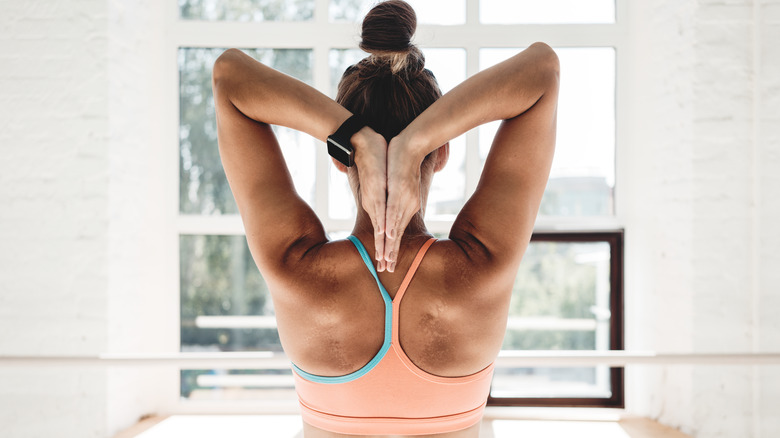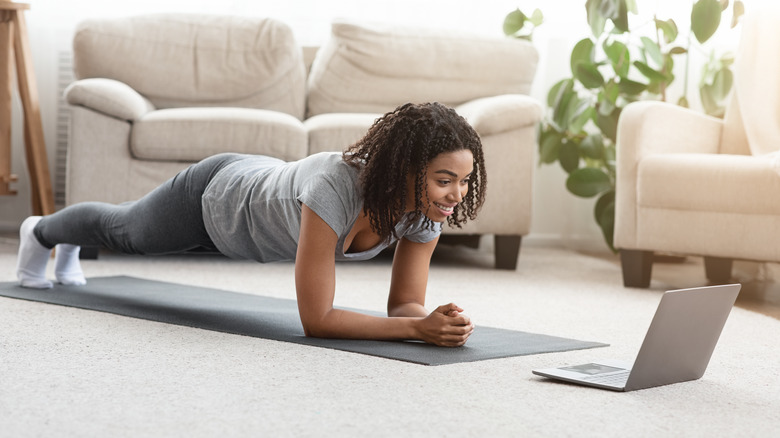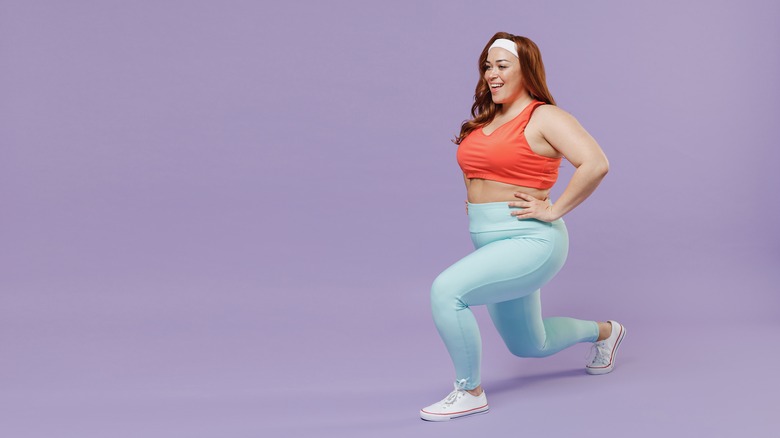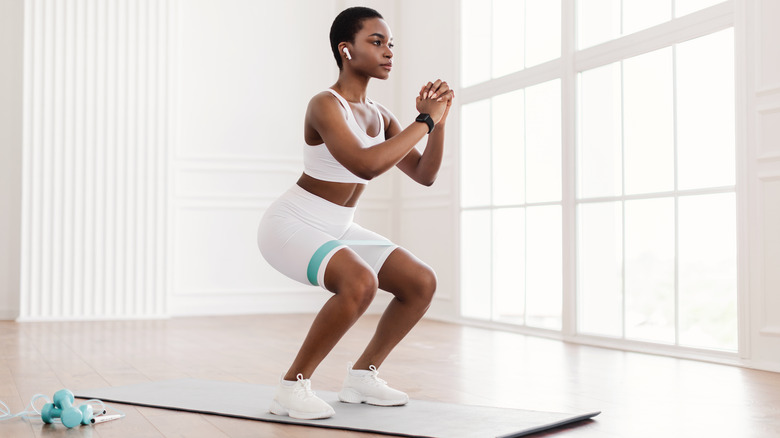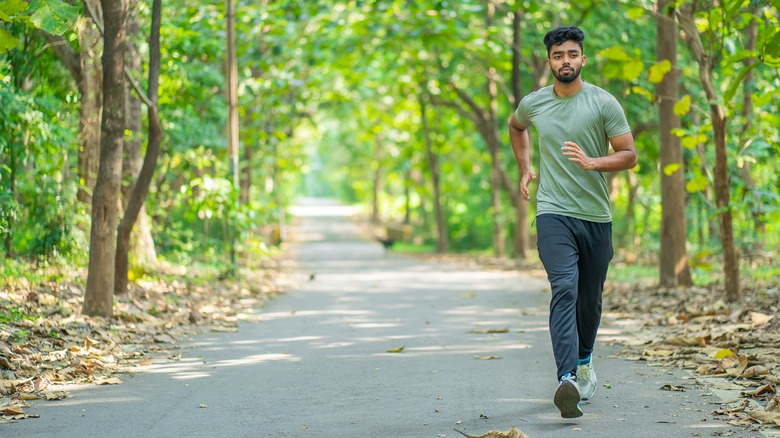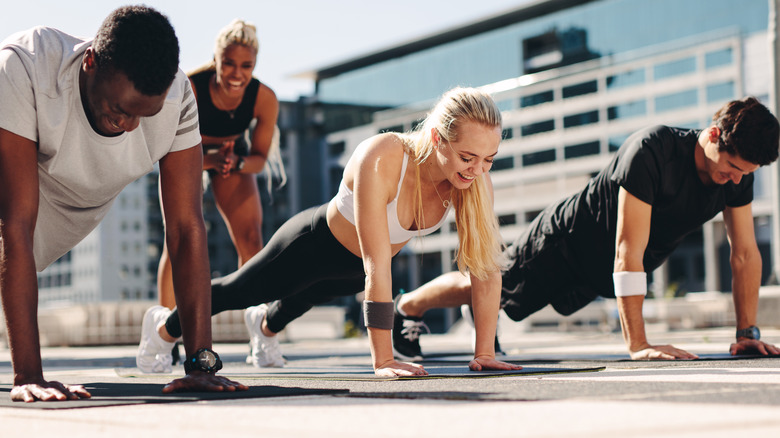The Best Quick Exercises To Fit Into Your Busy Day
Exercise is key if you're looking to boost your energy levels, improve your mood, or simply feel great in your own skin. To make exercise more effective, it helps to set specific, measurable, and achievable goals. This will help you stay motivated and on track with your routine. That being said, consulting with your doctor is vital before engaging in any exercise routine. Also, be sure to engage in a proper warm-up before every workout session. A warm-up sets your body up for more intense exercise, as per OrthoInfo. It also prepares you mentally and should only last for about 10 minutes, says NHS Inform. Warming up should consist of light cardio exercises, such as fast-paced walking or arm swings. You can also do dynamic stretching exercises, such as range-of-motion exercises, like jumping Jacks (per Harvard Health Publishing).
However, not everybody has the time to head to the gym or stick to a consistent gym routine. Luckily, there are some quick and effective exercises most people can fit into their daily routine.
A basic plank
For starters, the plank exercise works the core muscles and engages the upper body and legs, per Healthline. The basic plank is done by holding the body in a straight line, supported by the toes and forearms, while keeping the abs and glutes tight. To perform a plank exercise, start by getting into a push-up position with your hands placed directly under your shoulders, according to WebMD. Raise your shoulder blades and push yourself off the floor, keeping your legs straight and knees off the floor. If possible, hold the pose for 30 seconds.
Although the plank is a challenging exercise, it can be modified or scaled to suit your fitness level, says Healthline. In addition, it's a great way to strengthen your core and can be done anywhere with little to no equipment. However, it's important to maintain proper form and focus on engaging your core throughout the exercise to get the most out of it.
Lunges
Lunges are a type of exercise that primarily works the muscles in the legs, specifically the quadriceps, glutes, and hamstrings (via Healthline). They are a great way to build strength and help prepare your muscles for everyday use. Luckily, they can be modified to target different muscle groups. This makes them versatile exercises that can be incorporated into any workout regimen. In other words, you can bust out a few while waiting to heat your food at home or while walking your dog.
To perform a lunge, start by standing with your feet hip-width apart. Take a step forward with one foot, and bend your front knee 90 degrees to lower your body down towards the ground. Your back leg should also bend, with the knee hovering just above the ground. Keep your torso straight and engage your core during the pose before pushing through your front heel back to the original position.
Squats
Squats primarily target the muscles in the lower body, specifically the calves, quadriceps, and glutes, explains Healthline. They work the core and lower back muscles as stabilizers. Like with lunges, squats can be done with your body weight or free weights, such as barbells or dumbbells, or kettlebells, as per Healthline. Again though, these don't have to be done in a gym. They can be done on a commercial break when watching your favorite television series or just any moment you have a couple of minutes.
To perform a basic bodyweight squat, sand with your feet apart and chest lifted, according to WebMD. Slowly lower your body by bending your knees at 90 degrees. While squatting, be sure your weight falls on your heels, hold for a few seconds and push through your heels to straighten your legs and return to the starting position. With that being said, maintaining proper form during squats is important to avoid injury and ensure that you are targeting the correct muscles.
If you're new to squats or have knee or back pain, it's best to consult a fitness specialist on proper form before adding weight to your routine.
Walking
Walking is a simple and accessible form of exercise that can provide various health benefits. Some benefits of daily walking include improved cardiovascular health, weight management, and stronger bones and muscles, explain the experts at Mayo Clinic. In fact, regular walking can also lower your blood pressure and improve memory and cognition.
Starting a daily walking routine can be simple. First, you need to set a goal for your walking routine, whether it's to improve overall fitness, lose weight, or get more active. However, you'll want to start with a shorter distance and gradually increase the distance over time (via Mayo Clinic). You can use apps or a pedometer to track your progress. The key is to be consistent and make walking a habit. Nevertheless, walk at a comfortable pace and listen to your body. Slow down or take a break if you feel tired or out of breath. Finally, keep it interesting. In other words, walking the same route every day can get boring, so try to mix things up by exploring new routes, walking with a friend, or listening to music or audiobooks while you walk.
Push-ups
Like other forms of exercise, push-ups have many benefits. For one, they are a classic and highly effective exercise that can help to build upper body strength and improve muscle tone, according to Healthline. They are considered a compound exercise. In other words, they target multiple muscle groups at once, including the tricep, anterior deltoid, and pectoralis muscles. Additionally, push-ups are a great way to increase cardiovascular fitness. In fact, a higher push-up capacity can lower the incidence of cardiovascular disease, as per a 2019 study published in JAMA Network Open.
Luckily, push-ups are relatively easy to perform and again, can be modified to suit different fitness levels. To do a push-up, start by positioning yourself in a plank position with your hands shoulder-width apart (via Healthline). Lower your body down towards the ground by bending your elbows, keeping your back in a straight line. Push back up to the starting position, squeezing your tricep and chest muscles.
To increase or decrease difficulty, you can modify your push-up routine by doing them on your knees instead of your toes. This makes them suitable for all fitness levels, from beginners to advanced athletes. However, it always helps to start with a manageable number of reps and gradually increase the number of reps over time. However, listen to your body and avoid overtraining to avoid injury.

